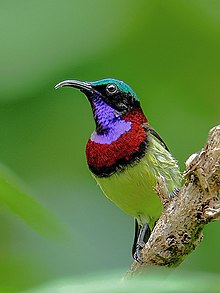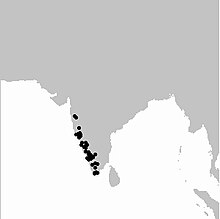
The white-rumped vulture is an Old World vulture native to South and Southeast Asia. It has been listed as Critically Endangered on the IUCN Red List since 2000, as the population severely declined. White-rumped vultures die of kidney failure caused by diclofenac poisoning. In the 1980s, the global population was estimated at several million individuals, and it was thought to be "the most abundant large bird of prey in the world". As of 2021, the global population was estimated at less than 6,000 mature individuals.

The grey treepie, also known as the Himalayan treepie, is an Asian treepie, a medium-sized and long-tailed member of the crow family. The species was first described by Robert Swinhoe in 1863. They are widely distributed along the foothills of the Himalayas in the Indian Subcontinent and extending into Indochina, southern mainland China and Taiwan. The populations vary in plumage and several are named as subspecies.

Sunbirds and spiderhunters make up the family Nectariniidae of passerine birds. They are small, slender passerines from the Old World, usually with downward-curved bills. Many are brightly coloured, often with iridescent feathers, particularly in the males. Many species also have especially long tail feathers. Their range extends through most of Africa to the Middle East, South Asia, South-east Asia and southern China, to Indonesia, New Guinea and northern Australia. Species diversity is highest in equatorial regions.

The black-rumped flameback, also known as the lesser golden-backed woodpecker or lesser goldenback, is a woodpecker found widely distributed in the Indian subcontinent. It is one of the few woodpeckers that are seen in urban areas. It has a characteristic rattling-whinnying call and an undulating flight. It is the only golden-backed woodpecker with a black throat and a black rump.

The purple sunbird is a small bird in the sunbird family found mainly in South and Southeast Asia but extending west into parts of the Arabian peninsula. Like other sunbirds they feed mainly on nectar, although they will also take insects, especially when feeding young. They have a fast and direct flight and can take nectar by hovering like a hummingbird but often perch at the base of flowers. The males can appear all black in harsh sunlight but the purple iridescence is visible on closer observation or under good light conditions. Females are olive above and yellowish below.

The purple-rumped sunbird is a sunbird endemic to the Indian Subcontinent. Like other sunbirds, they are small in size, feeding mainly on nectar but sometimes take insects, particularly when feeding young. They can hover for short durations but usually perch to suck nectar from flowers. They build a hanging pouch nest made up of cobwebs, lichens and plant material. Males are brightly coloured but females are olive above and yellow to buff below. Males are easily distinguished from the purple sunbird by the light coloured underside while females can be told apart by their whitish throats.
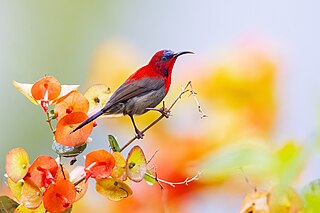
The crimson sunbird is a species of bird in the sunbird family which feed largely on nectar. They may also take insects, especially when feeding their young. Flight is fast and direct on their short wings. Most species can take nectar by hovering like a hummingbird, but usually perch to feed. It has also been unofficially announced as Singapore’s national bird by the Nature Society Singapore.

Loten's sunbird, also known as the long-billed sunbird or maroon-breasted sunbird, is a sunbird endemic to peninsular India and Sri Lanka. Named after Joan Gideon Loten, who was the Dutch governor of colonial Ceylon, it is very similar to the purple sunbird that is found in the same areas and also tends to hover at flowers for nectar, but can be distinguished by the longer bill, the maroon band on the breast and brownish wings. Like other sunbirds, it is also insectivorous and builds characteristic hanging nests.

The variable sunbird or yellow-bellied sunbird, Cinnyris venustus, is a sunbird. The sunbirds are a group of small Old World passerine birds which feed largely on nectar, although they will also take insects, especially when feeding young. Flight is fast and direct on their short wings. Most species can take nectar by hovering like a hummingbird, but usually perch to feed most of the time.

The red-vented bulbul is a member of the bulbul family of passerines. It is a resident breeder across the Indian subcontinent, including Sri Lanka extending east to Burma and parts of Bhutan and Nepal. It has been introduced in many other parts of the world and has established itself in New Zealand, Argentina, Tonga and Fiji, as well as parts of Samoa, Australia, USA and Cook Islands. It is included in the list of the world's 100 worst invasive alien species.
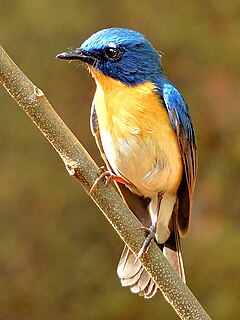
Tickell's blue flycatcher is a small passerine bird in the flycatcher family. This is an insectivorous species which breeds in tropical Asia, from the Indian Subcontinent eastwards to Bangladesh and western Myanmar. The Indochinese blue flycatcher was formerly considered conspecific. They are blue on the upperparts and the throat and breast are rufous. They are found in dense scrub to forest habitats.
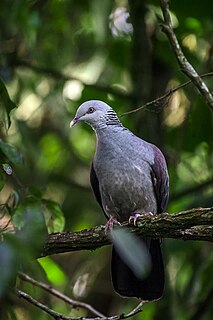
The Nilgiri wood pigeon is large pigeon found in the moist deciduous forests and sholas of the Western Ghats in southwestern India. They are mainly frugivorous and forage in the canopy of dense hill forests. They are best identified in the field by their large size, dark colours and the distinctive checkerboard pattern on their nape.

Mudumalai National Park is a national park in the Nilgiri Mountains in Tamil Nadu, south India. It covers 321 km2 (124 sq mi) at an elevation range of 850–1,250 m (2,790–4,100 ft) in the Nilgiri District and shares boundaries with the states of Karnataka and Kerala. A part of this area has been protected since 1940. The national park has been part of Nilgiri Biosphere Reserve since 1986 and was declared a tiger reserve together with a buffer zone of 367.59 km2 (141.93 sq mi) in 2007. It receives an annual rainfall of about 1,420 mm (56 in) and harbours tropical and subtropical moist broadleaf forests with 498 plant species, at least 266 bird species, 18 carnivore and 10 herbivore species. It is drained by the Moyar River and several tributaries, which harbour 38 fish species.

The white-cheeked barbet or small green barbet is a species of Asian barbet found in southern India. It is very similar to the more widespread brown-headed barbet, but this species has a distinctive supercilium and a broad white cheek stripe below the eye and is found in the forest areas of the Western Ghats, parts of the Eastern Ghats and adjoining hills. The brown-headed barbet has an orange eye-ring but the calls are very similar and the two species occur together in some of the drier forests to the east of the Western Ghats. Like all other Asian barbets, they are mainly frugivorous, and use their bills to excavate nest cavities in trees.

The pale-billed flowerpecker or Tickell's flowerpecker is a tiny bird that feeds on nectar and berries, found in India, Sri Lanka, Bangladesh and western Myanmar. The bird is common especially in urban gardens with berry bearing trees. They have a rapid chipping call and the pinkish curved beak separates it from other species in the region.

The painted bush quail is a species of quail found in the hill forests of India. They move in small coveys on hillsides and are distinguished by their red bills and legs. They have a liquid alarm call and small groups will run in single file along paths before taking flight when flushed.
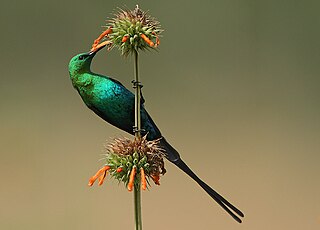
The malachite sunbird is a small nectarivorous bird found from the highlands of Ethiopia southwards to South Africa. They pollinate many flowering plants, particularly those with long corolla tubes, in the Fynbos.

The scarlet-tufted sunbird is a species of bird in the Nectarinia of the family Nectariniidae. It is found in Democratic Republic of the Congo, Kenya, Malawi, Rwanda, Tanzania, Uganda, and Zambia. It is also known as the red-tufted sunbird and the scarlet-tufted malachite sunbird.
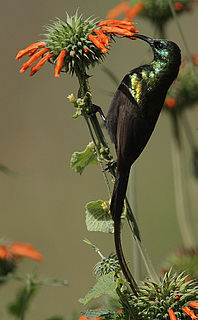
The bronzy sunbird is a species of bird in the family Nectariniidae. They are located mostly in parts of southern Africa.
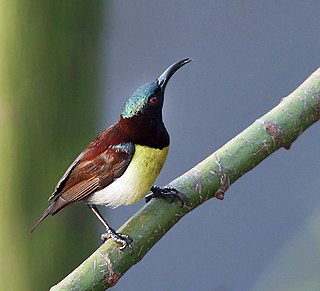
Leptocoma is a genus of sunbirds found from tropical South Asia to Papua New Guinea. Its members are sometimes included in Nectarinia.
